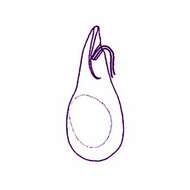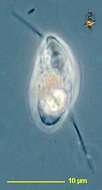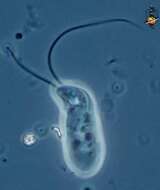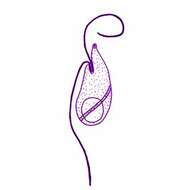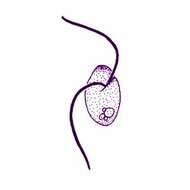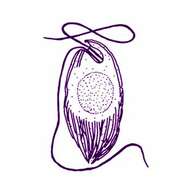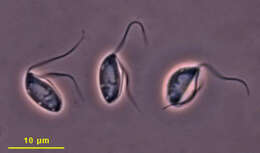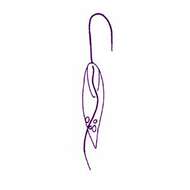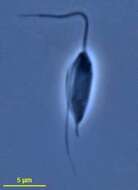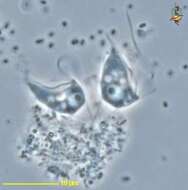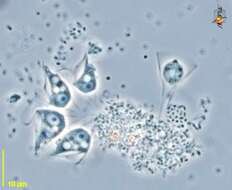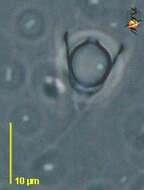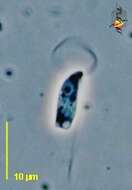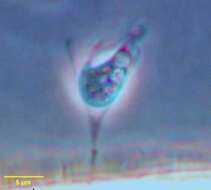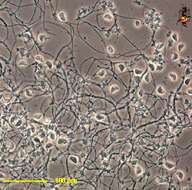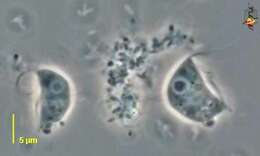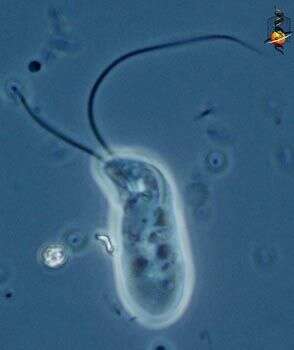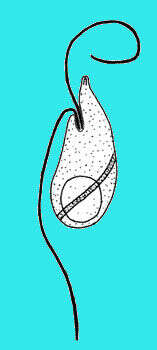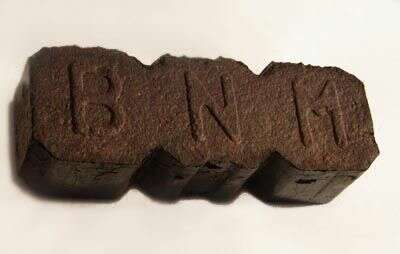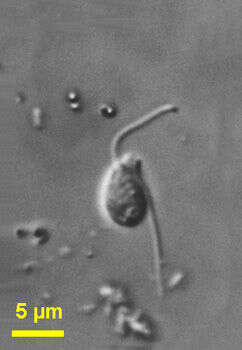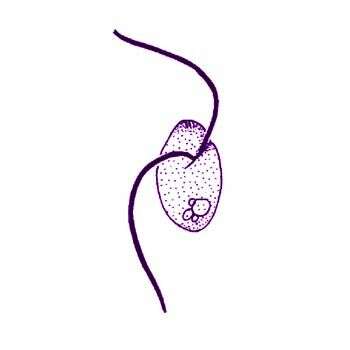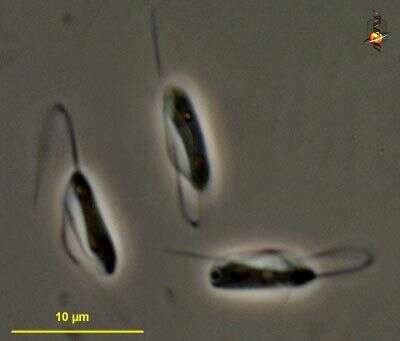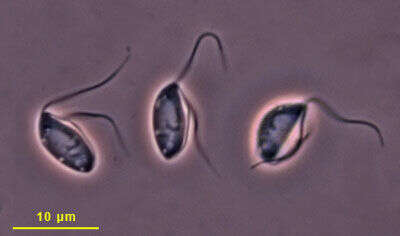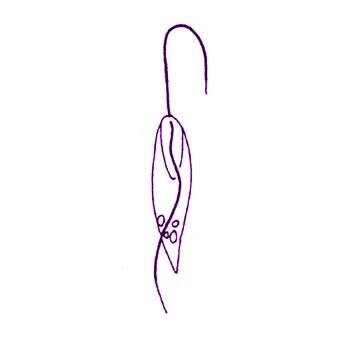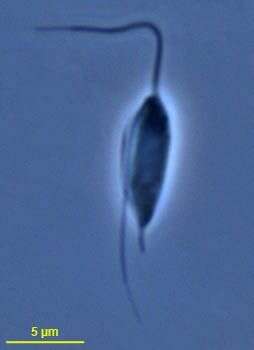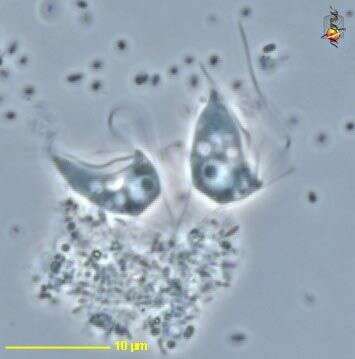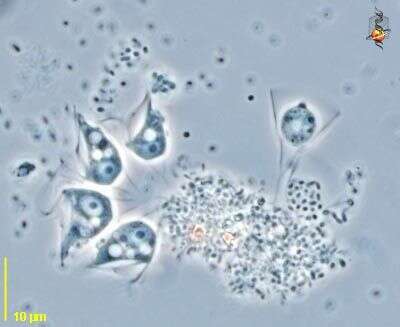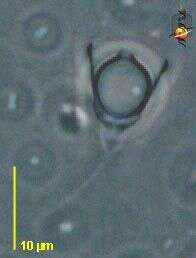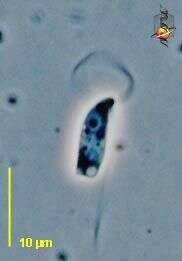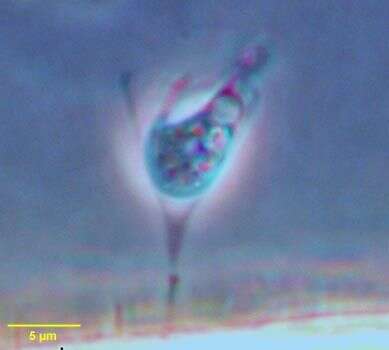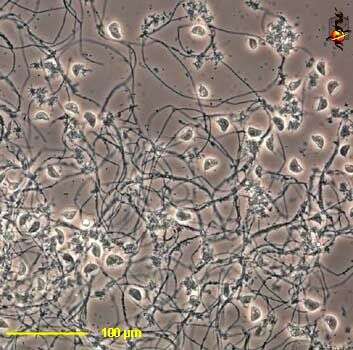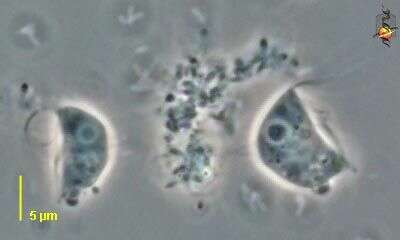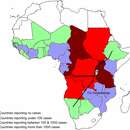-
Leptomonas buetschlii Kent, 1880. Cells elongate fusiforme, pointed at each end, but most attenuate posteriorly, eight or nine times as long as wide, flagellum nearly twice the cell length, a contractile vacuole is situated near the anterior end, and a little behind this a dark, granular, nucleus-like body. Length 11.3 microns
-
Diplonema ambulator Larsen and Patterson, 1990. Cells are 14-23 microns long, cylindrical with two short thickened flagella (about 8microns long) inserting into a prominent flagellar pocket. The body is metabolic, with conspicuous food vacuoles containing bacteria and algal cells.
-
Hemistasia (hem-is-stays-ee-a) is one of a small number of genera that make up the diplonemids, a subset of euglenozoa. Although not widely reported, they are often encountered in especially marine habitats where they consume detritus, algae, and other moderately sized particles. They have two flagella which insert into a shallow subapical pocket. There are three genera which look similar: Rhynchopus with a papillum and relatively deep flagellar pocket, Diplonema with two short flagella, and Hemistasia with long flagella. The species are polymorphic, making species and generic boundaries very hard to establish. Because of the absence of the papilla, and the long flagella, we have tentatively assigned this to Hemistasia. With slightly thickened flagella (like most euglenozoa), metaboly (like euglenids) but not with a pellicle of interlocking strips. Common but not often reported. Phase contrast.
-
Hemistasia (hem-ee-stays-ee-a), one of the diplonemid flagellates. With thickened flagella (like most euglenozoa), metaboly (like euglenids) but not with the pellicle. This genus also has a spiral groove on the surface of the body. Common but not often reported. There are three genera which look similar: Rhynchopus with a papillum and relatively deep flagellar pocket, Diplonema with two short flagella, and Hemistasia with long flagella. The species are polymorphic, making species and generic boundaries very hard to establish. We assign this organism to Rhynchopus because of the papillum. Phase contrast.
-
Hemistasia (hem-ee-stays-ee-a) is one of a small number of genera that make up the diplonemids, a subset of euglenozoa. Although not widely reported, they are often encountered in especially marine habitats where they consume detritus, algae, and other moderately sized particles. They have two flagella which insert into a shallow subapical pocket. There are three genera which look similar: Rhynchopus with a papillum and relatively deep flagellar pocket, Diplonema with two short flagella, and Hemistasia with long flagella. The species are polymorphic, making species and generic boundaries very hard to establish. Differential interference contrast.
-
-
Hemistasia (hem-ee-stays-ee-a) phaeocysticola (Scherffel, 1900) Elbrèchter et al., 1996. Cell outline is pyriform to oblong. Cells are about 13 to 33 microns long, metabolic, with a flexible apical papillum and with an indistinct spiral groove. Two flagella insert subapically in a pocket, are unequal in length and wrap around the body during feeding. The posterior flagellum is slightly longer than the anterior flagellum and the cell. During swimming cells rotate. The cells often contain one large food vacuole in the posterior part of the cell. Rarely observed.
-
Hemistasia phaeocysticola (Scherffel, 1900) Elbrachter et al., 1996. Cell outline is pyriform to oblong. Cells are about 13 to 33 microns long, metabolic, with a flexible apical papillum and with an indistinct spiral groove. Two flagella insert subapically in a pocket, are unequal in length and wrap around the body during feeding. The posterior flagellum is slightly longer than the anterior flagellum and the cell. During swimming cells rotate. The cells often contain one large food vacuole in the posterior part of the cell.
-
Bordnamonas (board-na-moan-ass) named after the Irish Peat Marketing Board. This is a Bord na Mona peat briquette.
-
Bordnamonas (board-na-moan-ass) tropicana - the orientation of the two flagella is characteristic of swimming cells. The apical mouth is visible.
-
Bordnamonas tropicana Larsen and Patterson, 1990. Cells are 4 to 11 microns long, 2.5 to 4 microns wide, flattened, and flexible, particularly when squashed. The cells are anteriorly narrow and posteriorly broad. Two slightly thickened flagella, similar in length, insert subapically in the right ventral side of the cell and are approximately 1.5 times the length of the cell. The flagella are not acronematic. The anterior flagellum beats stiffly and is held in a sigmoid arc, and the posterior flagellum curves near its flagellar insertion and is directed towards the rear of the cell. An apical mouth is visible by light microscopy. The cells move by gliding or rapidly by skidding close to the substrate.
-
Section through a beat bog from which peat 'bricks' are dug. Traditionally, the peat is allowed to dry, but Bord-na-mona peat briquettes are a compressed product.
-
Postgaardi mariagerensis Fenchel et al., 1995. Fixed cells examined in detail by light microscopy were 16-25 microns long (n = 15) and oval shaped with somewhat pointed ends. Two thick flagella, each about 2.5 times the length of the cell body insert in a large anterior depression. The cell is covered by longitudinally arranged rod-shaped epibiotic bacteria. In fixed material some of these bacteria can be seen peeling off from the flagellate. The nucleus is positioned somewhat anterior to the middle of the cell. The nuclear material has a lumpy appearance when viewed with Nomarski optics, suggestive of condensed chromatin. There is a prominent central nucleolus.
-
Jakoba (yak-obe-a) one of the excavate flagellates, so called because of the ventral groove or gutter in which the recurrent flagellum lies. One anterior flagellum is held in front of the cell like a crook (shepherd+s not criminal). Originally from marine sites. Phase contrast micrograph.
-
Images of an un-named species of Jakova. The recurrent flagellum has a vane near its base, and lies in the ventral groove that serves to define the broader grouping to which the jakobids belong - the excavates. The mitochondrion extends along the dorsal margin of the cell and is visible as a dark inclusion. Material from Tom Nerad, images by Charley O'Kelly. Phase contrast.
-
Jakoba libera (Ruinen, 1938) Patterson, 1990. The organism is a biflagellated protist with an acutely obovate cell body measuring 6-9.5 microns long, with most cells 7-8 microns in length. The anterior flagellum is inserted apically. It measures about one and a half times the length of the body and is held in a hook shape. The posterior flagellum is inserted slightly subapically, is about the same length as the anterior flagellum and lies in a ventral groove of the body. Normally it beats actively. Both flagella are acronematic. The cells may swim but usually adhere to debris with the crook of the anterior flagellum. They may deform and squirm when compressed in debris. During feeding, the posterior flagellum creates a current of water from which bacteria are removed. Bacteria are collected in the groove, ingested, and the resulting food vacuoles are found mostly in the posterior part of the cell.
-
-
Histiona (hist-ee-own-a) is a jakobid flagellate related to Jakoba. As with other excavates, there is a ventral groove and the flagella insert at the head of the groove. There are two flagella, one lying in the groove and one curving outwards from the point of insertion. The margins of the groove can be mistaken for flagella. Unlike most other excavates, Histiona sits in a stalked lorica when feeding. Phase contrast.
-
Histiona (hist-ee-own-a) is a jakobid flagellate related to Jakoba. As with other excavates, there is a ventral groove and the flagella insert at the head of the groove. There are two flagella, one lying in the groove and one curving outwards from the point of insertion. The margins of the groove can be mistaken for flagella. Unlike most other excavates, Histiona sits in a stalked lorica when feeding. Lorica with a cyst is evident. Phase contrast.
-
Histiona (hist-ee-own-a) is a jakobid flagellate related to Jakoba. As with other excavates, there is a ventral groove and the flagella insert at the head of the groove. There are two flagella, one lying in the groove and one curving outwards from the point of insertion. Unlike most other excavates, Histiona sits in a stalked lorica when feeding. This is a lorica and an enclosed but vacated cyst. Phase contrast.
-
Histiona (hist-ee-own-a) is a jakobid flagellate related to Jakoba. As with other excavates, there is a ventral groove and the flagella insert at the head of the groove. There are two flagella, one lying in the groove and one curving outwards from the point of insertion. These are the characteristics of the feeding cells, but they can also separate from the lorica and swim around. This is a swimming cell (theront). Phase contrast.
-
Histiona, small heterotrophic flagellate, located ina stalked lorica, gives the impression of relaxing. From a freshwater pond near Boise, Idaho.
-
Reclinomonas (ree-cline-owe-moan-ass) is a jakobid flagellate, cells lie recumbent in a stalked lorica, two similar flagella emerge from the anterior apex, one often lying within a ventral groove and the other projecting. Population in debris. Phase contrast.
-
Reclinomonas (ree-cline-owe-moan-ass) is a jakobid flagellate, cells lie recumbent in a stalked lorica, two similar flagella emerge from the anterior apex, one often lying within a ventral groove and the other projecting. May also have a rod projecting from the ventral face. Nuclei located anteriorly. Phase contrast.


